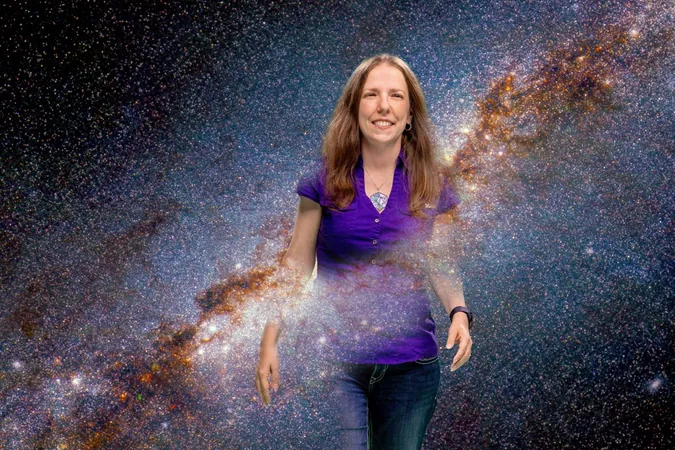
COSMOS-Web Unveils Unprecedented Glimpse into the Universe
2025-06-05
Author: Wei Ling
A New Era for Astronomical Discovery
The COSMOS-Web initiative has marked a groundbreaking achievement as the largest General Observer program selected for Cycle 1 of the James Webb Space Telescope (JWST). Led by Jeyhan Kartaltepe, an associate professor at the Rochester Institute of Technology, this project has now made its comprehensive dataset publicly available, providing a treasure trove of information about our universe.
Unlocking the Secrets of Early Galaxies
With this release, researchers and the public gain unprecedented access to deep space data, revealing previously unseen early galaxies. The COSMOS-Web survey mapped a total sky area equivalent to three full moons, utilizing advanced tools like the Near Infrared Camera (NIRCam) and the Mid Infrared Instrument (MIRI).
Kartaltepe emphasized the remarkable capabilities of JWST, stating, "The sensitivity allows us to observe much fainter and more distant galaxies than ever before, letting us explore their properties in detail. The quality of the data is astonishing, surpassing our expectations."
COSMOS2025: A Catalog of Cosmic Wonders
The newly released COSMOS2025 catalog encapsulates the properties of nearly 800,000 galaxies, merging data from JWST with earlier observations. This extensive resource is designed to be easily searchable, dramatically simplifying the research process for scientists and enthusiasts alike.
Marko Shuntov, a postdoctoral researcher at the Cosmic DAWN Center, noted the intensive collaboration required to create the catalog. He remarked, "This ambitious project involved innovative technology to measure the morphology and photometry of these galaxies across 37 images, yielding some of the highest quality data available for groundbreaking research.”
A Data Goldmine for Future Research
The sheer volume of data gathered was so immense that it would have taken scientists years to analyze manually. By releasing the catalog, the COSMOS-Web team has removed these barriers, allowing the scientific community to dive straight into data exploration.
Revolutionizing Our Understanding of the Universe
The insights gained from JWST’s observations have fundamentally altered our understanding of early galaxies and their formation processes. Maximilien Franco, another postdoctoral researcher, described the achievement: "By combining over 10,000 images, we’ve created the largest continuous image from JWST, revealing galaxies that were once hidden from view."
MIRI's intricate role includes assessing the mass of these distant galaxies and examining star formation throughout cosmic history, showcasing its importance in confirming the existence of the most remote galaxies ever discovered.
Empowering Future Innovations with AI
The catalog not only encompasses extensive data but also features an interactive viewer, granting users the ability to search for specific galaxies and analyze their characteristics. Recent studies stemming from COSMOS-Web are set to push scientific boundaries further by utilizing artificial intelligence to uncover galaxy properties.
Ghassem Gozaliasl, an astrophysicist at Aalto University, highlighted the significance of this research, stating, "Thanks to JWST and COSMOS-Web, we're now tracing the cessation of star formation and understanding how galaxies evolve over time, powered by AI-driven methods."
A Milestone in Cosmic Exploration
Since the JWST's launch in 2021, the COSMOS-Web team has undertaken extensive observations, aiming to unlock cosmic secrets such as the galaxy evolution during the Reionization Era and the relationship between dark and visible matter.
With over 250 hours of observation and continuous progress, the COSMOS-Web initiative promises to lead us into a golden age of astronomical discovery. Kartaltepe concluded, "We now have data and catalogs that offer a new window into the universe, transforming our understanding of cosmic phenomena."




 Brasil (PT)
Brasil (PT)
 Canada (EN)
Canada (EN)
 Chile (ES)
Chile (ES)
 Česko (CS)
Česko (CS)
 대한민국 (KO)
대한민국 (KO)
 España (ES)
España (ES)
 France (FR)
France (FR)
 Hong Kong (EN)
Hong Kong (EN)
 Italia (IT)
Italia (IT)
 日本 (JA)
日本 (JA)
 Magyarország (HU)
Magyarország (HU)
 Norge (NO)
Norge (NO)
 Polska (PL)
Polska (PL)
 Schweiz (DE)
Schweiz (DE)
 Singapore (EN)
Singapore (EN)
 Sverige (SV)
Sverige (SV)
 Suomi (FI)
Suomi (FI)
 Türkiye (TR)
Türkiye (TR)
 الإمارات العربية المتحدة (AR)
الإمارات العربية المتحدة (AR)